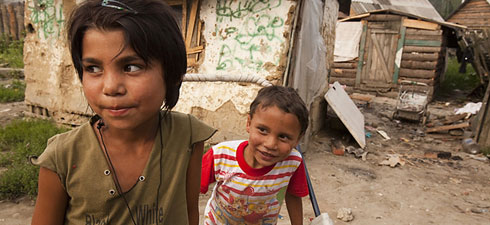In the Trans-Carpathian village of Berehovo, right on the border with the European Union [Hungary], hundreds of people are living behind a concrete wall. In shacks made of earth and wood, in incredible poverty.
Smelly rooms with cracked and mouldy walls sealed with cardboard and rags, with leaky ceilings, clay floors and plastic sheets for windows serve as homes for local Roma families with their many children. It’s a nationality that – as confirmed by human rights organisations from Ukraine – just gets in everyone’s way.
Just before the European Football Championship began, the gypsy camp in the Kiev suburb of Berezniaky was burned down. Probably because the Roma had built their shanties near the railway tracks, which would be bringing thousands of fans to the football championships.
400,000 Roma live in the Ukraine
Not even in the closed ghettos, where they live “among their own”, can the Ukrainian Roma be said to be thriving. Those in Berehovo sleep on bunks made of hay, rags and cardboard. In courtyards crowded with junk and garbage, extremely unappetising food is cooked right on the ground, in big kettles hung above an open fire. Free-roaming dogs sniff at dirt-crusted potatoes, and linen is washed in dirty water. At least here nobody is attacking us, they say.
Naked young children roll in the dust and horse manure in the Transcarpathian village. The only signs of civilisation are mobile phones and satellite dishes on roofs with holes in them.
“We cook in dirty and stinking water. All the children have diarrhoea. We’re praying for at least one pump,” says Aranka, who lives on the Berehovo “reservation” with eight children. Adults and children, they say, suffer from dysentery and tuberculosis. The shanties are full of rats, against which the Roma deploy scrawny tomcats, often tied to a string. Roma young and old fight lice with hair dye. Even toddlers sport bright red hair.
According to statistics from Roma organisations, up to 400,000 Roma live in the Ukraine. Rudolf Papp, representative of the NGO “Future of Berehovo Roma”, says it is difficult even to determine precisely how many people are living behind the concrete wall of the settlement.
“We have equal legal standing”
Families are constantly in search of better livelihoods. Their only income is often social benefits, such as birth and parental allowances and the pensions of older family members. The problem, it appears, is that many Roma in Ukraine have no documents and so cannot apply for the benefits.
The Roma aren’t complaining about the life “behind the wall”. According to Papp, the wall around the Roma settlement is comfortable for the Roma community and suits the local residents too. Nobody forces them to stay there, and they can move about as they please.
“We have equal legal standing with the Ukrainians and Hungarians. Our children can go to school and women can give birth in hospitals,” Papp says. He admits, however, that not all Roma make use of these privileges.
The main problem, as he sees it, is that men cannot get work because of their nationality. Families often live by sending their children to beg and old women to “work” in the markets or train stations. Some of the Roma evidently traffic in drugs. Their camps are resplendent with good things. They live in houses behind castellated walls and ride about in limousines.
According to Vitaly Kulik, Director of the Research Centre for Civil Society Problems, integrating Roma into society is a huge problem.
The romance is long gone
“In Soviet times the authorities tried to handle relations through the so-called barons. These informal mechanisms failed, though, and created room for even greater criminalisation of this community,” he said.
According to human rights workers, Roma in Ukraine are a totally neglected community that no one takes any interest in. “It's a nation that’s been forgotten. The government does not want to bother with them, because solving their problems would cost a huge amount of money. They’re considered a marginal ethnic group,” reported the radio station Radio Liberty, quoting Volodymyr Batčajev from the Ukrainian Association for Monitoring Compliance with Human Rights.
In Soviet times the authorities tried to integrate Roma into mainstream society forcibly. Nomadic life was outlawed, Roma children had to attend school and men had to work, primarily in agriculture.
Roma culture was also promoted. A forthright cult film, “Queen of the Gypsies”, directed by the Moldovan director Emil Lotianu, was shot right in the Transcarpathian villages.
The romance of films is long gone from the Roma camps, and today they are dominated by misery and crime. As in other European countries, Roma society is despised in the Ukraine. The only thing still popular about it are restaurants with colourful gypsy bands.
Was this article useful? If so we are delighted!
It is freely available because we believe that the right to free and independent information is essential for democracy. But this right is not guaranteed forever, and independence comes at a cost. We need your support in order to continue publishing independent, multilingual news for all Europeans.
Discover our subscription offers and their exclusive benefits and become a member of our community now!












